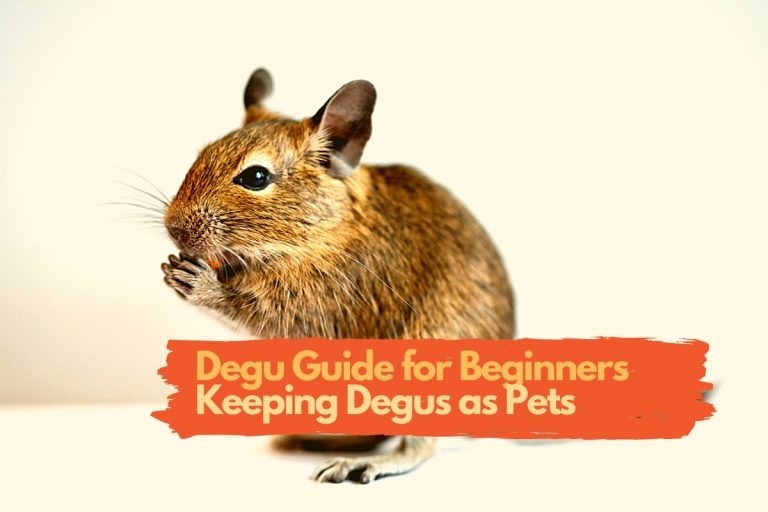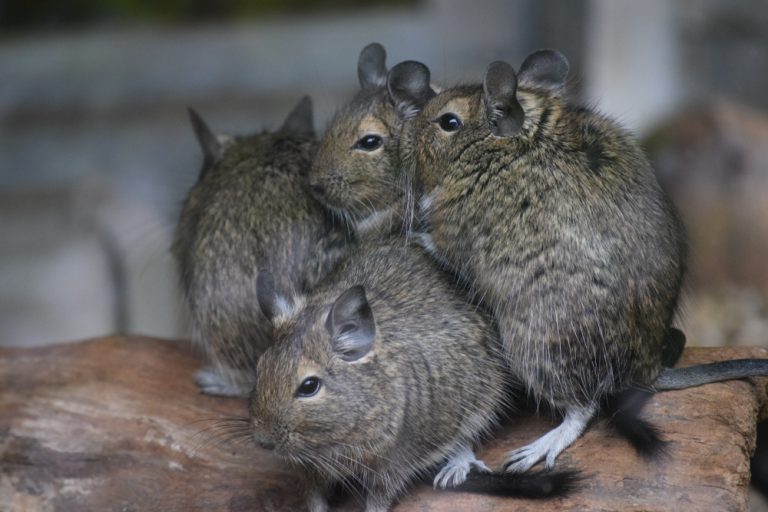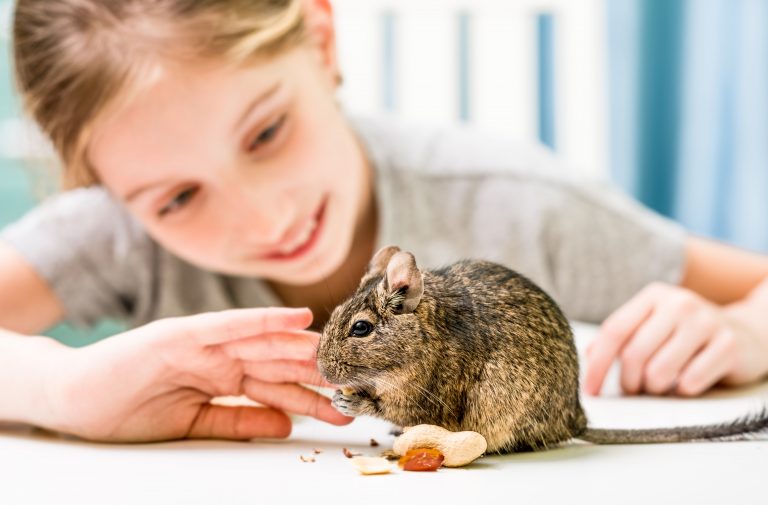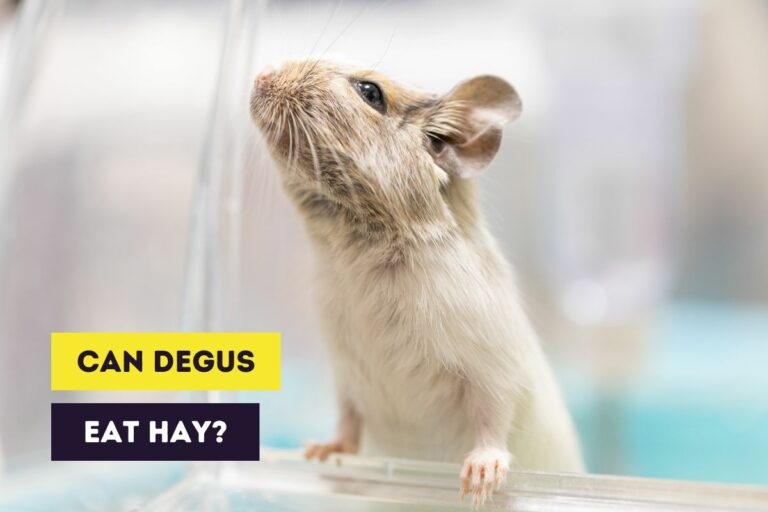The Degu Care Guide: How to Take Care for Your Degus?
You’re reading Degu Care in Degus: The Complete Guide for Noobs. Quickly navigate to other chapters: Intro | Preparing for a Degu | Buying a Degu | Degu Care
You’ve bought a couple or group of degus and are ready to start caring for them. Degus are quite low-maintenance pets and their care is quite easy compared to some other pets. Still, they have some specific dietary needs and taming them can take a while.
To give your degus the best possible care, it’s important to learn all aspects of degu care. So, let’s start learning everything there is to know about degu care right now!
This site contains affiliate links to products we recommend and use ourselves. We may receive a commission for purchases that you make through these links. If you’re interested in learning more about our affiliate links, please visit our (affiliate) disclaimer.
First Days
Getting your degus adjusted to their home
When you get back home with your degus you’ll need to let them adjust to you and to their new surroundings. Place your degus in their new cage when you get back home and let them explore the cage without disturbing them too much the first day. You should have already placed food in the bowl and fresh water in the water bottle. Don’t try to handle your degus the first day. This will cause stress and might even lead to a bite.
Getting your degus adjusted to you
The following days should establish a certain routine that your degus can get used to. Speak to your degus and get them used to your presence. You’ll have to interact with your degus daily by taking out their food bowl and giving them fresh food. When you notice that your degus are interested in you and don’t run and hide when you open the cage door, you should take the first steps in handling and taming.
These first steps are fairly simple and you shouldn’t wait too long to take them. Open the cage door and reach in the cage with your hand. Let it hang in for a few minutes. At this point, you shouldn’t try to grab your degus. Just let it hang in the cage. Degus are curious animals and will want to explore your hand and sniff it. When the sniffing is done, slowly take your hand outside the cage and close the cage door.
Congratulations, you can now start taming and training your degus so you can handle them with ease.
How Do You Handle Degus?
Degus are smart and curious animals but contrary to other pet rodents they usually don’t like being picked up and handled. They do like to walk freely on your body from your arm to your shoulder but this is a more “advanced” handling technique that requires weeks to obtain.
In the meantime, you’ll need to take your degus out of their cage on several occasions. This is why you’ll need to learn some basic handling techniques. If you’ve got these mastered you can start learning some more advanced handling techniques.
Basic handling techniques
There are some basic techniques you can use to “handle” your degus. With handling, I also mean a way to transport your degus from their cage to another destination, like a playpen. There are some easy techniques that don’t require you to grab or touch your degus.
Jar technique
The jar technique can not only be used by children but also by you when you’re not that sure about handling your new degus. For this technique, you’ll need a jar or a can that’s large enough to fit your degu comfortably. Lower the jar in the cage and face the opening of the jar towards your degu. Curious degus will want to explore the jar and get in. If our degu doesn’t get in the jar, you can gently push it towards the jar.
The jar technique is obviously not really a technique where you handle a degu. It’s a way to get your degus out their cage and transport them, for example to their playpen. It’s important to keep the top of the jar covered while you transport your degu in it. Degus will try to jump out of the jar and when they succeed they might fall from a large height or escape in the room.
Tunnel technique
The tunnel technique can be compared to the jar technique but uses a carboard tunnel instead of a jar or container. Since degus live in burrows and use tunnels all the time in the wild they will gladly get in the cardboard tunnel.
You’ll need a large enough cardboard tunnel (both in width and length) for this technique. Place one end of the tunnel in the cage and let your degu explore it. Just as with the jar technique, most degus will get into the tunnel but sometimes they might need some extra encouragement. This encouragement can be in the form of a treat in the tunnel.
The tunnel technique is also not really a technique where you handle a degu. It’s a way to get your degus out their cage and transport them, for example to their playpen. It’s important to keep the ends of the tunnel covered while you transport your degu in it. Degus will try to run out of the tunnel and when they succeed they might fall from a large height or escape in the room.
Two-handed (“cup”) technique
The easiest technique to pick up a degu is the two-handed or cup technique. This technique consists of nothing more than forming a cup with your hands and using this “cup” to pick up your degu. Slide your hands underneath the degu and lift it slowly and gently out the cage. You might want to place one hand underneath your degu and the other one on top of your degu to lessen the chance of your degu falling or escaping.
Advanced handling techniques
Open-hand technique
The open-hand technique takes some time and training to learn to your degus. It involves learning your degus to come to your hand, climb up and walk on your arms. Degus usually won’t stay still on your hand and will like to climb around.
One-hand technique
If you’ve got a tame degu that’s used to being handled you can use the one-hand technique. Lower one hand in the cage and grasp your degu around its middle with the fingers pointed towards the degu’s head. If your degu is used to being handled and you don’t hold too tight your degu will not try to bite or free itself.
Tips and tricks for handling degus
It can be difficult to handle degus, especially if you’re not used to handling small pets. To give you a head start I’ve gathered some tips and tricks for you:
- don’t force your degu: you don’t want to chase your degus around their cage. This will be stressful for your degus, which might lead to you getting bitten. Let your degu come to you and make sure that they want to be handled.
- each degu is different: most degus will not like being picked up or handled, while some degus will love the attention of humans.
- never pick up a degu up by its tail: degus drop their tail as an anti-predator reaction. This way they can still escape when a predator is able to grab them by their tails. The tail won’t grow back!
- take precautions to avoid falls: degus are small animals and when they fall from large heights they can get severely injured. Don’t walk around when handling your degu unless you’re sure that they can’t fall or jump.
- don’t use gloves: if you’re afraid of getting bitten you might use gloves to handle your degus but this isn’t a very good idea. If your degus really bite you, they can still get through thick gloves. When you use gloves you might not hold your degus firm enough or you might hold them too tightly. Both are not good: your degu might escape or it might have trouble breathing. It’s best to just handle them “glove-free”.
Degu Training
Hand training
Training your degu to come to you is not that easy and will take some time. Luckily, degus are curious animals that want to explore and learn more about you. Just as with other pets, training will be accompanied by giving a small treat. Below is a little summary of the different steps in training your degu.
How to train a degu?
Learn to come to your open hand
Place your open hand in the cage and let your degus come to your hand and sniff it. If they do this, give them a small treat. Repeat this step a few days until they naturally come up to your hand.
Learn to place their paws in your open hand
Don’t give any treats for coming up to your hand anymore. Only give a treat when your degu puts its forepaws on your open hand.
Learn to climb on your open hand and arms
This step might need some extra encouragement and time. Give a treat when your degu climbs on your open hand and arms. You can encourage your degu to do this by placing some healthy treats on your hand.
Learn to walk from your hand to arms
The final step in training your degu to be handled is to learn it to walk from your open hand to your arms. Pick up your degu and let them walk on your arms, then you should put it down gently and give a treat.
Command training
Command training is a way to learn your degus to respond in a certain way when you tap with your fingers and give voice commands. Degus are smart animals that can be learned, for example, to come to you or to return to their cage. Command training involves a great deal of time and effort. Because this is just a starter guide I won’t get into command training any further.
Degu Care Basics
Feeding your degus
Degus are crepuscular creatures in nature and will forage and feed in the morning and evening. To mimic this natural feeding schedule it’s recommended to feed your degus each day in the morning and/or evening. There are a lot of sources that advise you to give access to food ad libitum, which means at all times, but this isn’t a good idea. The only exception is hay which should be available to your degus freely.
Dietary Schedule
You can find an entire feeding schedule for your degus by clicking the following tables.
Daily
- fresh hay: give your degus meadow hay or timothy hay each day and remove the hay from the day before. If you don’t remove the old hay it can get moldy. For convenience, place the hay in a hay rack or a ceramic bowl.
- pellet food: give a total of 10 grams of pellet food per degu each day. You can give all of it in the morning or evening or choose to divide it between the morning and evening. Place the pellet food in a ceramic bowl and make sure that each degu has it’s own bowl.
- fresh leafy vegetables and dried herbs: slice the vegetables to thumb-sized pieces and give only a few pieces in a ceramic bowl. Remove the remaining pieces the next day.
- water
Once or twice a week
- lucerne/alfalfa hay: alfalfa hay is high in protein and can lead to kidney problems if given too often. Mix it with other quality hay and only give it once or twice a week.
- other vegetables
- fresh herbs and grass
Never
- fresh fruits
- resins and molasses
- vegetables that are rich in sugar and starch
- bread
- garlic, onion, chives, and leeks
Playtime and exercise
Degus need a fair amount of exercise and the best way to give this is through playtime. You’ll need to provide enough toys and accessories in the cage of your degus or they will soon be bored and get stressed. One thing you’ll definitely need is a large enough exercise wheel. Degus can run several miles in an exercise wheel each day and it mimics aspects of the foraging behavior of degus.
Degus will also need to spend time outside of their cage and a playpen or play area outside of the cage is excellent for this. You should make sure that the playpen is large enough and that your degus can’t jump out of it or get through the bars and escape the pen.
Dust baths
Degus, like chinchillas, need to take dust baths. These dust baths help to keep your degus’ fur healthy and clean. Provide your degus with a dust bath at least twice a week. You can use a store-bought dust bath or a large bowl with high sides. The “dust” in a dust bath can be dusting clay or dust/sand suitable for chinchillas. Never use normal sand as this is not suitable for dust baths. Change the dust in the dust bath every week.
Cleaning the Degu Cage
Cleaning the cage is perhaps one of the less enjoyable aspects of caring for a degu but it obviously needs to happen. Most degu owners will clean the cage once per week although a lot will depend on the number of degus you have and the degree of cleanliness they have.
It’s important to not use chemical bleach or cleaners that contain ammonia. Degus are sensitive and can get harmed by the odor and fumes from chemical cleaning products. You should use eco-friendly and plant-based cleaning products and always rinse with warm water.
Health Problems
Signs of health problems
Degu care also means having attention for your degu’s health. It’s important to learn the difference between a healthy and sick degu. Here are some telltale signs of a sick degu.
Dull expression
Healthy degus have bright and fully open eyes when awake. If your degu looks dull and seems to have lost the spark in its eyes, this is a sign that something isn’t right.
Ruffled coat
The coat of your degu should be shiny and look healthy. Degus also groom their coat and don’t need a water bath to keep it nice and neat. They do need dust baths to keep their coat clean and healthy. If your degu has a ruffled coat this can be a sign that it doesn’t get enough dust baths or of an underlying skin condition.
Pale yellow or white teeth
Normal degu teeth have a yellow-orange color and this might scare you when you see it for the first time, it’s entirely normal. What isn’t normal is when they have yellow or white teeth. Yellow or white teeth are usually a sign of nutritional deficiencies.
Weight loss
A healthy degu has a compact body and weights between 6 and 14 ounces depending on their gender. Lack of appetite is often the cause of this weight loss.
Lethargic and not active
Degus are very active pets that will run and jump around almost the entire day. If your degu doesn’t seem active and goes around the cage with a lot of effort, this is definitely a sign of some health problem.
Not eating or drinking
Degus love to eat and get treats so when your degu doesn’t eat or drink this is a sign of a health issue.
Quiet degus
Degus aren’t quiet creatures and will communicate with other degus and you by making sounds. If your degu is unusually quiet this usually is also a sign of a problem.
Common health problems
Degus can get a few “common” health problems that can usually be avoided. To give you an idea of these common problems, here’s a list of these “minor” health issues:
- diabetes: degus are prone to diabetes and you should pay close attention to their diet. Limit food that is high in sugar or carbohydrates. Treats are often high in sugar or carbohydrates but if you limit the number of treats and the times you give them treats your degus usually will be fine.
- bumblefoot: degus that walk and run on a wire mesh floor can develop a condition called bumblefoot. Sores can develop in the feet of your degus and in such cases antibiotics will be necessary.
- spurs: spurs are a common dental problem of rodents. Spurs develop because they don’t get enough food to chew and wear down their teeth.
- dry skin: skin problems can be caused by a number of things like the diet or lack of dust baths. It’s best to seek the help of a vet when you see that your degu loses fur and has dry and flaky skin.
Your degu can also experience more dangerous and life-threatening conditions like cancer, bloating or cataracts. It’s important to seek the help of a specialized vet when you suspect that your degu has any of these problems.
What’s Next?
Congratulations, you’ve finished this guide! Now you can continue to learn more about degus in our advanced articles about breeding degus and baby degu care or one of the more in-depth articles about degu training, health problems of degus, the degu diet, and giving your degus enough exercise and playtime.







